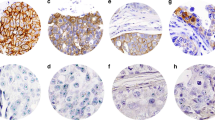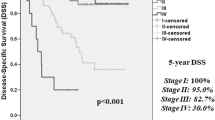Abstract
Expression of c-erbB3 protein was investigated in 104 primary breast carcinomas comprising nine comedo ductal carcinoma in situ (DCIS), 91 invasive ductal carcinomas and four invasive lobular carcinomas using two monoclonal antibodies, RTJ1 and RTJ2. Of the 91 invasive ductal carcinomas, seven contained the comedo DCIS component adjacent to the invasive component. An immunohistochemical technique was used to evaluate the association between expression of c-erbB3 and clinical parameters and tumour markers such as epidermal growth factor receptor (EGFR), c-erbB2, cathepsin-D and p53 in archival formalin-fixed paraffin-embedded tumour tissues. Our results indicated that RTJ1 and RTJ2 gave identical staining patterns and concordant results. It was found that the overexpression of c-erbB3 protein was observed in 67% (6/9) of comedo DCIS, 52% (44/84) of invasive ductal carcinomas, 71% (5/7) of carcinomas containing both the in situ and invasive lesions and 25% (1/4) of invasive lobular carcinomas. A significant relationship (P < 0.05) was observed between strong immunoreactivity of c-erbB3 protein and histological grade, EGFR and cathepsin-D, but not with expression of c-erbB2, p53, oestrogen receptor status, lymph node metastases or age of patient. However, we noted that a high percentage of oestrogen receptor-negative tumours (59%), lymph node-positive tumours (63%) and c-erbB2 (63%) were strongly positive for c-erbB3 protein. We have also documented that a high percentage of EGFR (67%), c-erbB2 (67%), p53 (75%) and cathepsin-D-positive DCIS (60%) were strongly positive for c-erbB3. These observations suggest that overexpression of c-erbB3 protein could play an important role in tumour progression from non-invasive to invasive and, also, that it may have the potential to be used as a marker for poor prognosis of breast cancer.
This is a preview of subscription content, access via your institution
Access options
Subscribe to this journal
Receive 24 print issues and online access
$259.00 per year
only $10.79 per issue
Buy this article
- Purchase on Springer Link
- Instant access to full article PDF
Prices may be subject to local taxes which are calculated during checkout
Similar content being viewed by others
Author information
Authors and Affiliations
Rights and permissions
About this article
Cite this article
Naidu, R., Yadav, M., Nair, S. et al. Expression of c-erbB3 protein in primary breast carcinomas. Br J Cancer 78, 1385–1390 (1998). https://doi.org/10.1038/bjc.1998.689
Issue Date:
DOI: https://doi.org/10.1038/bjc.1998.689
This article is cited by
-
Development of Effective Therapeutics Targeting HER3 for Cancer Treatment
Biological Procedures Online (2019)
-
Optimization of HER3 expression imaging using affibody molecules: Influence of chelator for labeling with indium-111
Scientific Reports (2019)
-
EGFR-TKIs resistance via EGFR-independent signaling pathways
Molecular Cancer (2018)
-
Phase 1 study of new formulation of patritumab (U3-1287) Process 2, a fully human anti-HER3 monoclonal antibody in combination with erlotinib in Japanese patients with advanced non-small cell lung cancer
Cancer Chemotherapy and Pharmacology (2017)
-
C-terminal domain of p42 Ebp1 is essential for down regulation of p85 subunit of PI3K, inhibiting tumor growth
Scientific Reports (2016)



